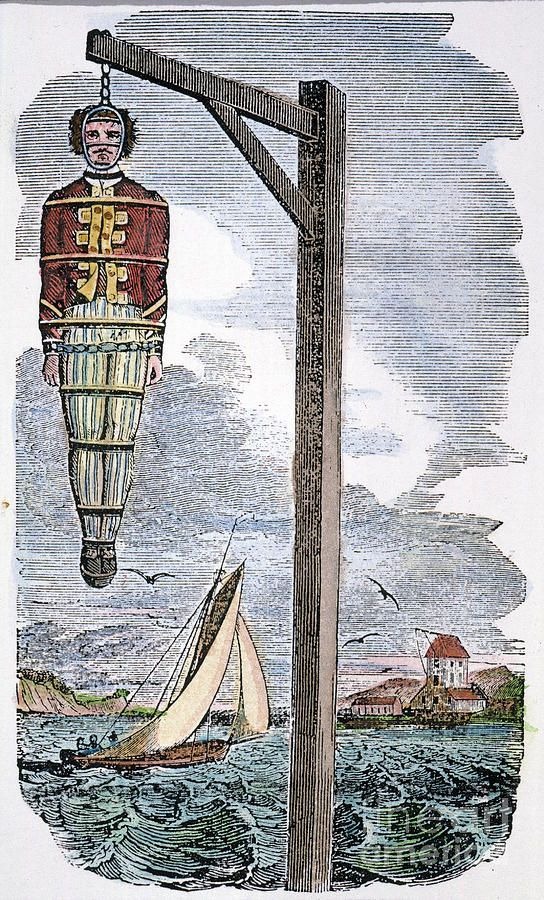Travellers to early modern London, while approaching the port city up the river Thames, were greeted by a ghastly sight. The riverbank was lined with gallows, from which hung a number of rotting corpses, bound in iron cages. They swung in the wind and made a horrid creaking noise that both terrified and offended wayfarers. But the gallows at London’s infamous Execution Dock would remain for nearly four hundred years.
This was a time when Britain was expanding its empire. The British crown, driven by commercial ambitions and the necessity to one-up the competition with Spain and France, began setting up colonies at far-flung places across the oceans. The crown traded extensively with its colonies. The colonies provided essential raw materials for England, and at the same time, served as markets for British manufactured goods.
A replica gallows by the River Thames in London. Photo credit: Toby Bradbury/Flickr
For this modern system of maritime commerce to succeed, Britain needed secure trade routes. In those days, and especially during the reign of Queen Elizabeth, piracy, or rather privateering, was a state-sponsored affair, actively supported by the crown and used as a tool of hostility against vessels of foreign nations. But Queen Elizabeth’s successors did not support the hiring of mercenaries. Privateering was abolished, and many privateers, used to the life of crime and riches, became pirates.
Piracy on the high seas was ruled a grievous crime, for it became a threat to maritime trade. The only punishment fitting for such a crime was death.
Maritime criminals including pirates, mutineers, and smugglers, who awaited the fatal punishment were held at Marshalsea Prison, from where they were transferred southeast to Wapping for public execution at Execution Dock. London had many public execution spots, but Execution Dock, by the Thames, was used specially for pirates.
The condemned man, or woman, was either carted or paraded through the streets from the prison to the Execution Dock, led by the Admiralty Marshal or one of his deputies. The Admiralty Marshal, riding on horseback, would carry a silver oar, an item which represented the authority of the Admiralty. Public executions were family affair. The streets would be lined with spectators and the riverbanks would be overflowing with them. Others would float on the river in packed boats. There would be men and women, old and young, as well as children —an immense crowd, all keen to see a man hang by his neck and die.
A 1795 engraving depicting a pirate being hanged at Execution Dock. It has also been suggested that the pirate is Captain James Lowry, hanged in 1762. Photo credit: Royal Museums Greenwich
On the way to the gallows, a pub named The Turks Head Inn, which is now a café, would serve the last quart of ale to the condemned pirate. Once at the scaffold, the pirate would be given the chance to make the last dying speech, in which he would either express regret for his actions or lash out violently against whoever he blamed for his fate. When this ritual was completed, the pirate would be hung by the neck until dead.
To make the ordeal as painful as possible, pirates were hung by a short rope. The shortened rope would make the drop insufficient to break the prisoner’s neck. Instead, the executed would die a slow death from strangulation. During the suffocation, the victim would writhe and struggle. This macabre display was nicknamed the ‘Marshal’s Dance’.
Hangings always took place at low tide. After the convict was dead, they waited until three tides had washed over the body before it was brought down. But the most notorious pirates would be left on display, hanging by the rope, and bound in an iron cage, known as a gibbet, to serve as warning to all those who would follow their footsteps.
The most famous criminal to be coated in tar and hung in a gibbet was Captain Kidd, who was convicted of piracy in 1701. His body remained hung for two years, some say three. It’s highly unlikely that his body remained hanging for twenty years, a figure that’s frequently quoted by some writers. It’s just one of the many fables and lore surrounding the infamous pirate.
The final hangings at the dock occurred on 16 December 1830.
Today, no one is sure where the Execution Dock’s gallows actually stood, as the originals are long gone. Although, there is a replica now just outside the nearly 500-year-old pub, Prospect of Whitby, by the Thames.
A woodcut showing the execution of two pirates at Wapping in 1583.

The gibbeted body of Captain Kidd who was executed at Wapping in 1701.
A pub in Wapping named after Captain Kidd. Photo credit: Felix Cohen/Flickr
In order to promote the launch of pirate drama ‘Black Sails’ on Amazon Prime Instant Video in 2014, men dressed as pirates were strung up in gibbets on a beach of the River Thames. Photo credit: Mischief PR

Photo credit: xpgomes10/Flickr
Sources: Wikipedia / Historic UK / BBC / englishlegalhistory.wordpress.com

















Comments
Post a Comment